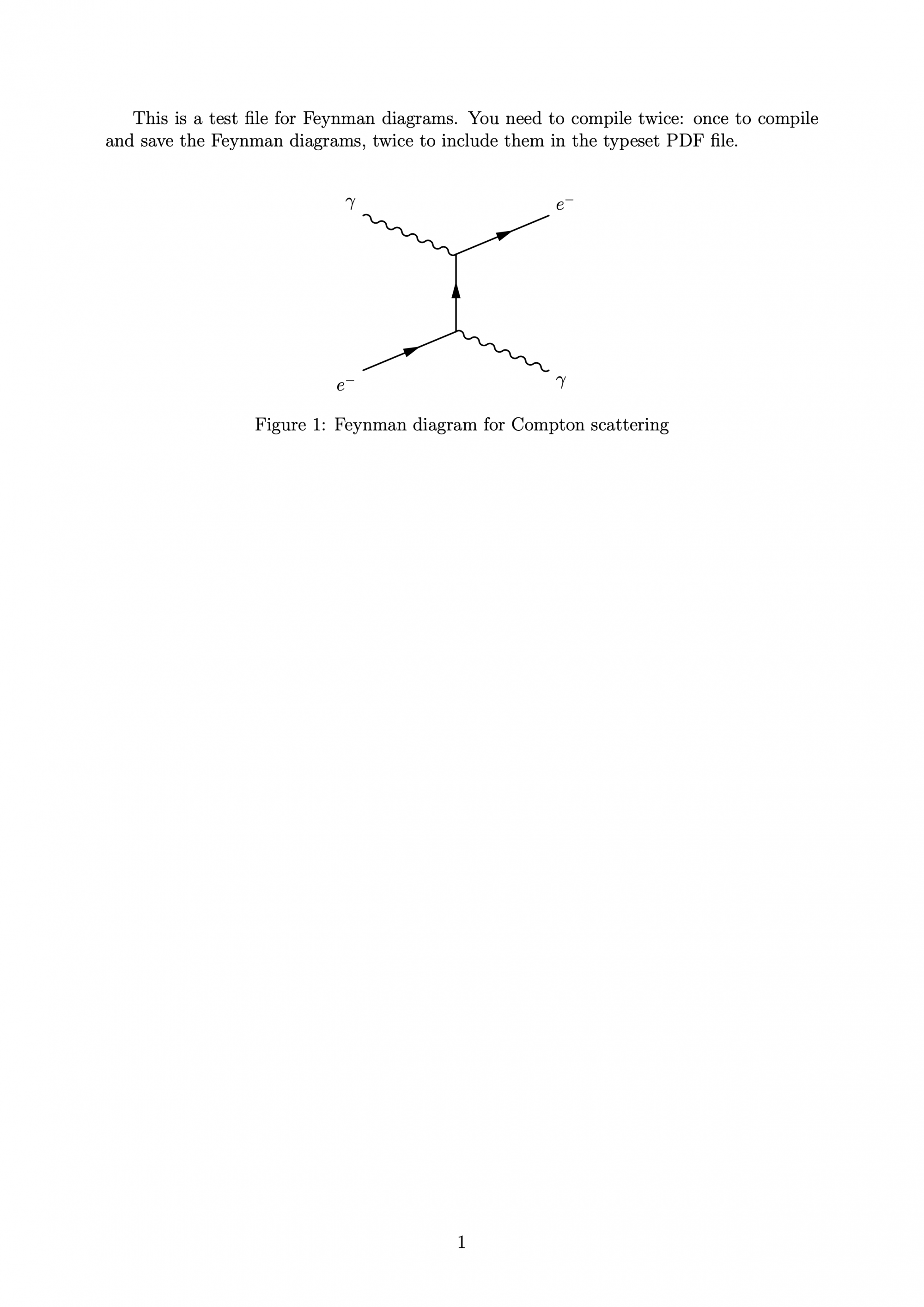Table of Contents
Generating Feynman diagrams in a LaTeX file
You may need to compile the LaTeX file twice with -shell-escape.
If you use TeXShop for macOS, you can include the following at the top of your document to automatically compile with pdflatexmk -shell-escape:
% !TEX program = pdflatexmk % !TEX parameter = -shell-escape
However, for Mac users however, feynmp in LaTeXiT is a better option to quickly build of Feynman diagrams as standalone images and use \includegraphics.
Method 1: feynmp-auto
Load the feynmp-auto package, documented here.
\usepackage{feynmp-auto}
- feynman_auto.tex
% !TEX program = pdflatexmk % !TEX parameter = -shell-escape % https://wiki.physik.uzh.ch/cms/latex:feynman_file#method_1feynmp-auto % https://www.overleaf.com/learn/latex/Feynman_diagrams#Other_packages_for_drawing_Feynman_diagrams \documentclass[a4paper,12pt]{article} \usepackage[margin=2.4cm]{geometry} % margins \usepackage{amsmath} \usepackage{graphicx} \usepackage{feynmp-auto} \begin{document} This is a test file for Feynman diagrams. You need to compile twice: once to compile and save the Feynman diagrams, twice to include them in the typeset PDF file. \begin{figure}[h] \vspace{10mm} \centering \begin{fmffile}{feynman-compton} \begin{fmfgraph*}(150,100) \fmfleft{i1,i2} \fmfright{o1,o2} \fmflabel{$\gamma$}{i2} \fmflabel{$e^-$}{i1} \fmflabel{$\gamma$}{o1} \fmflabel{$e^-$}{o2} \fmf{photon}{i2,v2} \fmf{fermion}{i1,v1,v2,o2} \fmf{photon}{v1,o1} \end{fmfgraph*} \end{fmffile} \vspace{5mm} \caption{Feynman diagram for Compton scattering} %\label{compton} \end{figure} \end{document}
Method 2: feynmp-auto (standalone)
To create a standalone Feynman diagram, use the standalone class:
- feynman_standalone.tex
% !TEX program = pdflatexmk % !TEX parameter = -shell-escape % Author: Izaak Neutelings (February 2023) \documentclass[10pt,border=2pt]{standalone} \usepackage{amsmath} \usepackage{feynmp-auto} \begin{document} \fmfframe(0,15)(0,15){ % padding (LTRB) \begin{fmffile}{feynman-compton} \begin{fmfgraph*}(110,80) \fmfleft{i1,i2} \fmfright{o1,o2} \fmflabel{$\gamma$}{i2} \fmflabel{$e^-$}{i1} \fmflabel{$\gamma$}{o1} \fmflabel{$e^-$}{o2} \fmf{photon}{i2,v2} \fmf{fermion}{i1,v1,v2,o2} \fmf{photon}{v1,o1} \end{fmfgraph*} \end{fmffile} } \end{document}
To create one multiple PDF with one Feynman diagram per page, add the option multi=page,crop to the standalone class and wrap each fmffile around the page environment:
% !TEX program = pdflatexmk % !TEX parameter = -shell-escape % Author: Izaak Neutelings (February 2023) \documentclass[10pt,border=2pt,multi=page,crop]{standalone} \usepackage{amsmath} \usepackage{graphicx} \usepackage{feynmp-auto} \begin{document} \begin{page} \fmfframe(0,15)(0,15){ % padding (LTRB) \begin{fmffile}{feynman-compton} \begin{fmfgraph*}(110,80) \fmfleft{i1,i2} \fmfright{o1,o2} \fmflabel{$\gamma$}{i2} \fmflabel{$e^-$}{i1} \fmflabel{$\gamma$}{o1} \fmflabel{$e^-$}{o2} \fmf{photon}{i2,v2} \fmf{fermion}{i1,v1,v2,o2} \fmf{photon}{v1,o1} \end{fmfgraph*} \end{fmffile} } \end{page} \begin{page} \fmfframe(0,15)(0,15){ % padding (LTRB) \begin{fmffile}{feynman-scat} \begin{fmfgraph*}(110,80) \fmfleft{i1,i2} \fmfright{o1,o2} \fmflabel{$\mu^-$}{i1} \fmflabel{$e^-$}{i2} \fmflabel{$\mu^-$}{o1} \fmflabel{$e^-$}{o2} \fmf{fermion}{i1,v1,o1} \fmf{fermion}{i2,v2,o2} \fmf{photon,label=$\gamma$}{v1,v2} \end{fmfgraph*} \end{fmffile} } \end{page} \end{document}
Method 3: Macro
This is a handy macro that allows you to compile Feynman graphs in LaTeX documents, without the need for extra scripts (source).
\usepackage{feynmp} % macro to compile Feynman graphs without extra scripts \DeclareGraphicsRule{*}{mps}{*}{} \makeatletter \def\endfmffile{ \fmfcmd{\p@rcent\space the end.^^J end.^^J endinput;} \if@fmfio \immediate\closeout\@outfmf \fi \ifnum\pdfshellescape>\z@ \immediate\write18{mpost \thefmffile} \fi} \makeatother
Simply include the macro in the preamble. (Tested only in TeXShop on a Mac.)
- feynman_macro.tex
% !TEX program = pdflatexmk % !TEX parameter = -shell-escape % https://wiki.physik.uzh.ch/cms/latex:feynman_file#method_1feynmp-auto % https://www.overleaf.com/learn/latex/Feynman_diagrams#Other_packages_for_drawing_Feynman_diagrams \documentclass[a4paper,12pt]{article} \usepackage[margin=2.4cm]{geometry} % margins \usepackage{amsmath} \usepackage{graphicx} \usepackage{feynmp} % macro to compile Feynman graphs without extra scripts \DeclareGraphicsRule{*}{mps}{*}{} \makeatletter \def\endfmffile{ \fmfcmd{\p@rcent\space the end.^^J end.^^J endinput;} \if@fmfio \immediate\closeout\@outfmf \fi %\ifnum\pdfshellescape=\@ne \ifnum\pdfshellescape>\z@ \immediate\write18{mpost \thefmffile} \fi} \makeatother \begin{document} This is a test file for Feynman diagrams. You need to compile twice: once to compile and save the Feynman diagrams, twice to include them in the typeset PDF file. \begin{figure}[h] \vspace{10mm} \centering \begin{fmffile}{feynman-compton} \begin{fmfgraph*}(150,100) \fmfleft{i1,i2} \fmfright{o1,o2} \fmflabel{$\gamma$}{i2} \fmflabel{$e^-$}{i1} \fmflabel{$\gamma$}{o1} \fmflabel{$e^-$}{o2} \fmf{photon}{i2,v2} \fmf{fermion}{i1,v1,v2,o2} \fmf{photon}{v1,o1} \end{fmfgraph*} \end{fmffile} \vspace{5mm} \caption{Feynman diagram for Compton scattering} %\label{compton} \end{figure} \end{document}


